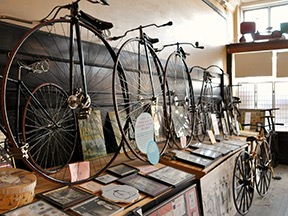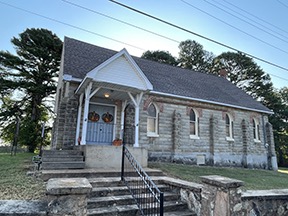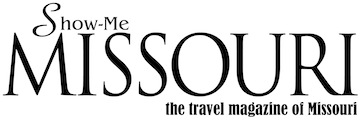Pedalers Bicycle Museum, Springfield
May 2025

The non-profit museum, which opened in 2010, is housed in an 1887 brick building in Springfield’s Commercial Street historic district. Some of the bicycles in the collection are even older than the building, with one of the oldest being an 1817 strider bike, a “walking bicycle” used by surveyors in Germany.
The Missouri Bicycle and Pedestrian Federation has called it “the best and most complete bicycle museum in Missouri, and one of the best in the country and world.”
A popular item with visitors is the 1911 bicycle built by Orville and Wilbur Wright (of Wright Brothers of aviation fame) after they stopped building aircraft. Another is a replica of the 1890s-era bicycles used by Buffalo Soldiers in the 25th Infantry Regiment of the U.S. Army Bicycle Corps for a trip between Missoula, Montana, and St. Louis in 1897. There’s even a 23.5-foot-long custom-built bicycle for 12, and at the opposite extreme, a unicycle with one wheel for one person.
The high-wheel or big-wheel bicycles, popular between 1877 and 1892, are among his favorites. These bikes pair one big wheel with one small wheel. The League of American Bicyclists is a national group that encourages restoring and riding antique bicycles. As a member of the state chapter, Allen has pedaled thousands of miles on a high-wheel bicycle, including a 3,270-mile cross-country journey from San Francisco to Boston in 1991.
Bicycles with equal-sized wheels were introduced in the 1890s and are mostly what we ride today. In the early days, the high-wheel bikes were called “ordinaries” and the equal-sized-wheel bikes were called “safeties,” because they were less dangerous to get on and ride than the high ones.
With some 800 bicycles in his collection and many of them in storage, Allen rotates the exhibits to display different pieces. He can spin off a story for every item in the museum, so a tour can last as long as the visitor has interest.
Among the memorabilia, there are photographs, posters, magazines, books, tools, antique beer steins and even bicycle-themed wine bottles.
Pedal on over to the Pedalers Bicycle Museum for a fascinating tour of two-wheelers through history.
Pedalers Bicycle Museum is located at 328 East Commercial Street and is open 11 a.m.-4 p.m. Tuesday through Thursday or by appointment or chance. Visitors should call 417-576-1464 to arrange group tours. Admission is free, but donations are welcome.
Koshkonong Historical Museum, Koshkonong
February 2025

As a one-woman marketing machine, she is determined to boost attendance at the museum and bring Koshkonong new fame as the closest access to Grand Gulf State Park—if she could just convince the state or the county to pave that 3.2-mile-long gravel road that leads from the railroad track crossing in town to the entrance of the park.
Reed took on the challenge of refreshing the museum and boosting attendance first as a volunteer and now as part of her duties as city clerk. She recently moved her office to the museum, and she hopes to institute regular visiting hours soon. For now, folks can call for an appointment to tour the museum. Her dream is to make the museum the official welcome center for Oregon County, the place people will visit to begin their exploration of Grand Gulf and other county attractions.
At one point in its storied past, Koshkonong boasted a population of 3,000 and was considered as a potential site for the state capital. Today, the population is 212, but don’t be fooled by that small number. There is still plenty of local pride, which is on full display at the annual OCHS Heritage Day in October.
The museum is housed in the 1909 Christian Church building, which later served as a Masonic Lodge until the OCHS bought it in 1994. It now belongs to the City of Koshkonong, as does the nearby 1902 jail house—definitely worth a stop.
The building is packed with items from Kosh (as the locals call it) and Oregon County. One of the most intriguing is the story of the 9-foot 1-inch giant skeleton of a man that was discovered in a nearby cave, along with deteriorating, handmade giant-size furniture. There is a photocopy of a story from the St. Louis Globe-Democrat dated September 9, 1885, about the discovery. Standing beside the life-size cut-out of the giant makes a great photo op.
Other items in the museum include the original telephone switchboard and several antique telephones, a collection of hundreds of ceramic shoes, vintage clothing, the original church bell, school desks and memorabilia, an old-fashioned washing machine and much more. Kosh’s history as a major peach-producing area in the 1890s is documented.
The City of Koshkonong Historical Museum is at the corner of Luyster and School streets. Admission is free but donations are accepted. To schedule a visit, call 417-867-3260. On Facebook, look for The City of Koshkonong Historical Museum.
